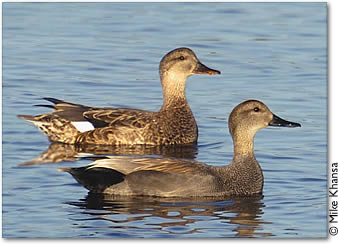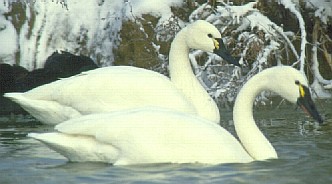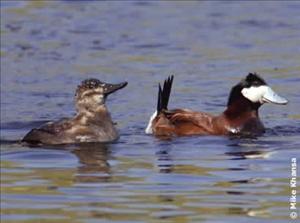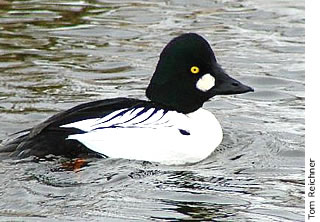Waterfowl Facts - The Great Salt Lake
The Great Salt Lake is arguably the most important waterfowl hotspot in the Intermountain West. There are 35 species of waterfowl numbering between 3-4 million that annually utilize its diverse wetland ecosystem for migration and breeding. John C. Fremont, an early explorer in the west, wrote in 1843 after visiting the Great Salt Lake near the Bear River Refuge: "the waterfowl made a noise like thunder…as the whole scene was animated with waterfowl."
Since then, habitats have drastically changed, water supplies have become limited, invasive species are rampant, waterfowl production is down, and we may never witness the once vast and impressive flocks that Fremont did. Yet, a healthy wetland ecosystem in the Great Salt Lake area remains absolutely critical for large segments of the continental population of many waterfowl species. The Great Salt Lake is of particular importance for Northern Pintails, Cinnamon Teal, Gadwall, Green-winged Teal, Tundra Swans, Redheads, Ruddy Ducks, Common Goldeneyes, Mallards, and Canada Geese (the Rocky Mountain Population).
 Northern Pintail - Great Salt Lake wetlands are one of the most important staging areas for pintails on the continent, currently supporting ~750,000 individuals, or about 25% of the North American population. Almost half of these pintails are from Saskatchewan, and along with several hundred thousand from Alberta, they migrate through the Great Salt Lake on their way to California's Central Valley for the winter. The Great Salt Lake is a pintail migration hub that also serves the Texas Gulf Coast and the Pacific coastal marshes of central Mexico. One pintail banded in the Great Salt Lake region was even recorded on Palmyra Island approximately 1,000 miles south of Hawaii. The Salton Sea also receives many of its wintering pintails from the Great Salt Lake.
Northern Pintail - Great Salt Lake wetlands are one of the most important staging areas for pintails on the continent, currently supporting ~750,000 individuals, or about 25% of the North American population. Almost half of these pintails are from Saskatchewan, and along with several hundred thousand from Alberta, they migrate through the Great Salt Lake on their way to California's Central Valley for the winter. The Great Salt Lake is a pintail migration hub that also serves the Texas Gulf Coast and the Pacific coastal marshes of central Mexico. One pintail banded in the Great Salt Lake region was even recorded on Palmyra Island approximately 1,000 miles south of Hawaii. The Salton Sea also receives many of its wintering pintails from the Great Salt Lake.
Pintails are also very common during the summer molt (~250,000), most coming down from southern Alberta and Saskatchewan. They begin arriving in June, peak in August, and have largely departed to their wintering grounds by November depending on winter severity around the Great Salt Lake. Pintails also utilize the marshes of the Great Sal Lake for breeding (~10,000), but to a lesser degree than other waterfowl as suitable nesting habitat is extremely limited. The Bear River Bird Refuge and the Willard Spur are extremely important for pintails. Their dense sego pondweed beds are some of the most productive anywhere in North America. Often during the fall migration, huge numbers of pintails can be found feeding and loafing in the Bear River Bay .
 Cinnamon Teal - Cinnamon teal are largely a Pacific Flyway duck with the majority of the population using the Great Basin (~150,000). The Great Salt Lake is the most important cinnamon teal breeding ground in North America and is internationally known for its importance as a significant proportion of the entire North American cinnamon teal population breeds here. Cinnamon teal are the first duck to migrate south from the Great Salt Lake, with over 99% of the continental population wintering south of the U.S.-Mexico border. Cinnamon teal prefer to brood rear in small waterways and ponds with abundant submergent and emergent vegetation. Prior to the lake flood, Ogden Bay WMA was the most important tract for cinnamon teal reproduction on the the Great Salt Lake and had the highest nest densities ever recorded. The common reed (Phragmites) invasion eliminated nearly all of the preferred saltgrass nesting areas and hemi-marsh brood rearing habitat. Cinnamon teal are the first duck to head south for the winter during the fall migration. Typically, they are mostly long gone before the waterfowl season begins.
Cinnamon Teal - Cinnamon teal are largely a Pacific Flyway duck with the majority of the population using the Great Basin (~150,000). The Great Salt Lake is the most important cinnamon teal breeding ground in North America and is internationally known for its importance as a significant proportion of the entire North American cinnamon teal population breeds here. Cinnamon teal are the first duck to migrate south from the Great Salt Lake, with over 99% of the continental population wintering south of the U.S.-Mexico border. Cinnamon teal prefer to brood rear in small waterways and ponds with abundant submergent and emergent vegetation. Prior to the lake flood, Ogden Bay WMA was the most important tract for cinnamon teal reproduction on the the Great Salt Lake and had the highest nest densities ever recorded. The common reed (Phragmites) invasion eliminated nearly all of the preferred saltgrass nesting areas and hemi-marsh brood rearing habitat. Cinnamon teal are the first duck to head south for the winter during the fall migration. Typically, they are mostly long gone before the waterfowl season begins.
 Gadwall - The Great Salt Lake is the largest breeding ground for gadwall in the western U.S. with about 65,000. The Great Salt Lake is also a major hub during migration with birds (~165,000) coming from and going to the Texas Gulf Coast, western Mexico, the Imperial and Central Valleys of California, and western Nevada's Carson Sink. The Farmington Bay Waterfowl Management Area is perhaps the most important areas for gadwall production and staging on the Great Salt Lake, followed by Ogden Bay, Harold Crane and Howard Slough Waterfowl Management Areas (WMA).
Gadwall - The Great Salt Lake is the largest breeding ground for gadwall in the western U.S. with about 65,000. The Great Salt Lake is also a major hub during migration with birds (~165,000) coming from and going to the Texas Gulf Coast, western Mexico, the Imperial and Central Valleys of California, and western Nevada's Carson Sink. The Farmington Bay Waterfowl Management Area is perhaps the most important areas for gadwall production and staging on the Great Salt Lake, followed by Ogden Bay, Harold Crane and Howard Slough Waterfowl Management Areas (WMA).
 Green-Winged Teal - The Great Salt Lake is "migration central" for green-winged teal with about 600,000 individuals, making this duck one of the most common migrants in the region. They are ubiquitous throughout each of the three main bay of the Great Salt Lake (Farmington Bay, Ogden Bay, and Bear River Bays). Peak counts at Farmington Bay WMA regularly reach 65,000 during fall migration. Ogden Bay, Harold Crane, and Howard Slough WMAs hold very large number of summer molting green-winged teal. But these numbers do not account for the massive flocks of staging birds out on the lake itself. Green-winged teal breed in the Boreal Forest of Canada and Alaska and are a focal species in Ducks Unlimited Western Boreal Forest Initiative. The Utah Division of Wildlife Resources annually reports that this duck is by far and away the number one bird in the bag during waterfowl season. Green-winged teal are one of the most exciting birds for hunters, particularly when a flock of a hundred birds descends into the decoy spread in a fast, whirling, and twisting ball.
Green-Winged Teal - The Great Salt Lake is "migration central" for green-winged teal with about 600,000 individuals, making this duck one of the most common migrants in the region. They are ubiquitous throughout each of the three main bay of the Great Salt Lake (Farmington Bay, Ogden Bay, and Bear River Bays). Peak counts at Farmington Bay WMA regularly reach 65,000 during fall migration. Ogden Bay, Harold Crane, and Howard Slough WMAs hold very large number of summer molting green-winged teal. But these numbers do not account for the massive flocks of staging birds out on the lake itself. Green-winged teal breed in the Boreal Forest of Canada and Alaska and are a focal species in Ducks Unlimited Western Boreal Forest Initiative. The Utah Division of Wildlife Resources annually reports that this duck is by far and away the number one bird in the bag during waterfowl season. Green-winged teal are one of the most exciting birds for hunters, particularly when a flock of a hundred birds descends into the decoy spread in a fast, whirling, and twisting ball.
 Tundra Swan - Roughly 75,000 tundra swans, or nearly 75% of the western population, migrate through the Great Salt Lake project area from mid-October through mid-December and again in March through April. During both migrations, tundra swans use the Bear River Bird Refuge and Farmington Bay duck clubs quite heavily. Other sites important for tundra swans include Salt Creek WMA and Farmington Bay WMA based on peak spring counts. Tundra swans rely heavily on abundant biomass and food energy available in the submerged aquatic vegetation beds in each of these three areas to fuel up before heading to California's Central Valley in the fall and to northern Canada in the spring. A special "swan tag" is required to hunt tundra swans in Utah. Hunters should be careful to discern between the numerous Tundra Swans and few numbers of Trumpeter Swans that use the Great Salt Lake during winter.
Tundra Swan - Roughly 75,000 tundra swans, or nearly 75% of the western population, migrate through the Great Salt Lake project area from mid-October through mid-December and again in March through April. During both migrations, tundra swans use the Bear River Bird Refuge and Farmington Bay duck clubs quite heavily. Other sites important for tundra swans include Salt Creek WMA and Farmington Bay WMA based on peak spring counts. Tundra swans rely heavily on abundant biomass and food energy available in the submerged aquatic vegetation beds in each of these three areas to fuel up before heading to California's Central Valley in the fall and to northern Canada in the spring. A special "swan tag" is required to hunt tundra swans in Utah. Hunters should be careful to discern between the numerous Tundra Swans and few numbers of Trumpeter Swans that use the Great Salt Lake during winter.
 Redhead - The Great Salt Lake is particularly important for breeding and migrating redheads (~150,000). Before the Great Salt Lake flooded in the 1980s, it held the greatest concentration of breeding redheads in North America by number of birds per wetland acre. Over the last two decades breeding redhead numbers have declined in step with growing non-native predator numbers and deteriorating wetland habitat conditions, particularly due to the loss of nesting habitat (bulrush stands) by common reed spread and loss of foraging habitats (pondweed beds) due to the effects of carp. Ducks Unlimited's conservation efforts in the region are helping to rebuild redhead production numbers by restoring the nesting habitat and tradition that was lost in the 1980's.
Redhead - The Great Salt Lake is particularly important for breeding and migrating redheads (~150,000). Before the Great Salt Lake flooded in the 1980s, it held the greatest concentration of breeding redheads in North America by number of birds per wetland acre. Over the last two decades breeding redhead numbers have declined in step with growing non-native predator numbers and deteriorating wetland habitat conditions, particularly due to the loss of nesting habitat (bulrush stands) by common reed spread and loss of foraging habitats (pondweed beds) due to the effects of carp. Ducks Unlimited's conservation efforts in the region are helping to rebuild redhead production numbers by restoring the nesting habitat and tradition that was lost in the 1980's.
 Ruddy Duck - Upwards of 26,000 ruddy ducks breed in the Great Salt Lake area. This is the largest breeding population outside of the prairie pothole region. The Great Salt Lake marshes are also a major migration (~50,000) route for ruddy ducks coming from central Alberta breeding grounds. Preferred nesting locations have abundant hardstem bulrush with adjacent water. Farmington Bay WMA and Howard Slough WMA are some of the prime ruddy duck production sites. Habitat quality on these areas has deteriorated affecting ruddy duck production in the same way as redhead production. Ogden Bay WMA stages large numbers of ruddy ducks and historically produced larger numbers, but after the lake flood nesting numbers and brood counts have declined.
Ruddy Duck - Upwards of 26,000 ruddy ducks breed in the Great Salt Lake area. This is the largest breeding population outside of the prairie pothole region. The Great Salt Lake marshes are also a major migration (~50,000) route for ruddy ducks coming from central Alberta breeding grounds. Preferred nesting locations have abundant hardstem bulrush with adjacent water. Farmington Bay WMA and Howard Slough WMA are some of the prime ruddy duck production sites. Habitat quality on these areas has deteriorated affecting ruddy duck production in the same way as redhead production. Ogden Bay WMA stages large numbers of ruddy ducks and historically produced larger numbers, but after the lake flood nesting numbers and brood counts have declined.
 Common Goldeneye - The Utah Division of Wildlife Resources' Great Salt Lake Ecosystem Project is investigating waterfowl use of the Great Salt Lake's western reaches. They recently found that this part of the lake is extremely important for wintering common goldeneye. An estimated 45,000 common goldeneye have been counted feeding on brine fly larvae during the winter. This newly discovered use of the Great Salt Lake by common goldeneye is one of the largest wintering inland populations ever recorded in North America. In fact, most waterfowl books show only marginal use of the Great Salt Lake by common goldeneye. They now need to be updated. Common goldeneye also forage on alkali bulrush seeds in the managed freshwater marshes during both fall and spring migrations. Common goldeney breed in the boreal forests of Canada and Alaska, and along with green-winged teal and scaup, are a focal species for DU's Western Boreal Forest Initiative.
Common Goldeneye - The Utah Division of Wildlife Resources' Great Salt Lake Ecosystem Project is investigating waterfowl use of the Great Salt Lake's western reaches. They recently found that this part of the lake is extremely important for wintering common goldeneye. An estimated 45,000 common goldeneye have been counted feeding on brine fly larvae during the winter. This newly discovered use of the Great Salt Lake by common goldeneye is one of the largest wintering inland populations ever recorded in North America. In fact, most waterfowl books show only marginal use of the Great Salt Lake by common goldeneye. They now need to be updated. Common goldeneye also forage on alkali bulrush seeds in the managed freshwater marshes during both fall and spring migrations. Common goldeney breed in the boreal forests of Canada and Alaska, and along with green-winged teal and scaup, are a focal species for DU's Western Boreal Forest Initiative.
 Mallard - Mallards are very common nesters (50,000) and a numerous migrant (375,000) in the Great Salt Lake's marshes. Habitat enhancements promoting sego pondweed and hardstem bulrush through the control of carp and common reed are needed to expand potential production habitats as well as improve migration and wintering areas. The spread of common reed has created large monotypic stands of dense vegetation that has replaced hemi-marsh conditions desirable by nesting and brood rearing mallards. Most of the mallards migrate through the Great Salt Lake to the Central Valley of California and to the Salton Sea, with only a modest amount remaining in the Great Salt Lake area through the winter.
Mallard - Mallards are very common nesters (50,000) and a numerous migrant (375,000) in the Great Salt Lake's marshes. Habitat enhancements promoting sego pondweed and hardstem bulrush through the control of carp and common reed are needed to expand potential production habitats as well as improve migration and wintering areas. The spread of common reed has created large monotypic stands of dense vegetation that has replaced hemi-marsh conditions desirable by nesting and brood rearing mallards. Most of the mallards migrate through the Great Salt Lake to the Central Valley of California and to the Salton Sea, with only a modest amount remaining in the Great Salt Lake area through the winter.
 Canada Goose - Approximately 30,000 Great Basin Canada geese use the Great Salt Lake throughout the year. These geese have become virtually non-migratory, however, some of these birds do migrate south to the lower Colorado River area. These birds have adapted to the expanding urban interface and spend most of the day on golf courses especially during nesting and molting. The Utah Division of Wildlife Resources conducts an annual goose banding effort. In 2007, a record number (~4,300) of geese were banded in and around the Great Salt Lake.
Canada Goose - Approximately 30,000 Great Basin Canada geese use the Great Salt Lake throughout the year. These geese have become virtually non-migratory, however, some of these birds do migrate south to the lower Colorado River area. These birds have adapted to the expanding urban interface and spend most of the day on golf courses especially during nesting and molting. The Utah Division of Wildlife Resources conducts an annual goose banding effort. In 2007, a record number (~4,300) of geese were banded in and around the Great Salt Lake.
Ducks Unlimited uses cookies to enhance your browsing experience, optimize site functionality, analyze traffic, and deliver personalized advertising through third parties. By continuing to use this site, you agree to our use of cookies. View Privacy Policy